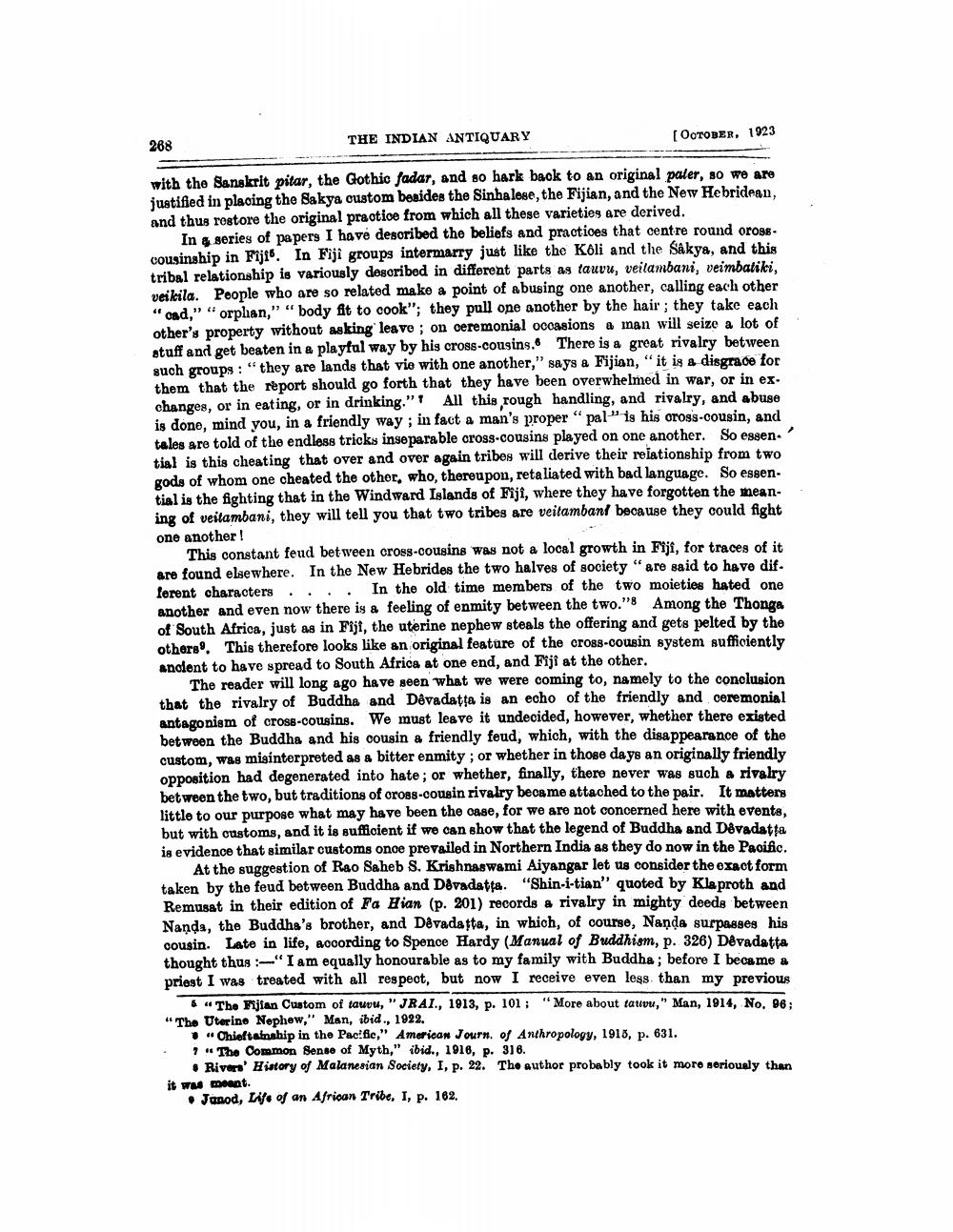________________
268
THE INDIAN ANTIQUARY
[OCTOBER, 1923
with the Sanskrit pitar, the Gothic fadar, and so hark back to an original paler, so we are justified in placing the Sakya custom besides the Sinhalese, the Fijian, and the New Hebridean, and thus rostore the original practice from which all these varieties are derived.
Inseries of papers I have described the beliefs and practices that centre round orosscousinship in Fiji. In Fiji groups intermarry just like the Koli and the Sakya, and this tribal relationship is variously described in different parts as tauvu, veilambani, veimbatiki, veikila. People who are so related make a point of abusing one another, calling each other "oad," " orphan," "body fit to cook"; they pull one another by the hair; they take each other's property without asking leave ; on ceremonial occasions a man will seize a lot of stuff and get beaten in a playful way by his cross-cousins. There is a great rivalry between such groups : "they are lands that vie with one another," says a Fijian, " it is a disgrace for them that the report should go forth that they have been overwhelmed in war, or in ex. changes, or in eating, or in drinking." All this rough handling, and rivalry, and abuse is done, mind you, in a friendly way; in fact a man's proper "pal” is his cross-cousin, and tales are told of the endless tricks inseparable cross-cousins played on one another. So essen.' tial is this cheating that over and over again tribes will derive their relationship from two gods of whom one cheated the other, who, thereupon, retaliated with bad language. So essen. tial is the fighting that in the Windward Islands of Fiji, where they have forgotten the meaning of veitambani, they will tell you that two tribes are veitamband because they could fight one another!
This constant feud between cross-cousins was not a local growth in Fiji, for traces of it are found elsewhere. In the New Hebrides the two halves of society" are said to have dif. ferent characters .... In the old time members of the two moieties hated one another and even now there is a feeling of enmity between the two." Among the Thonga of South Africa, just as in Fiji, the uterine nephew steals the offering and gets pelted by the othere. This therefore looks like an original feature of the cross-cousin system sufficiently andent to have spread to South Africa at one end, and Fiji at the other.
The reader will long ago have seen what we were coming to, namely to the conclusion that the rivalry of Buddha and Dévadata is an echo of the friendly and ceremonial antagonism of cross-cousins. We must leave it undecided, however, whether there existed between the Buddha and his cousin a friendly feud, which, with the disappearance of the custom, was misinterpreted as a bitter enmity; or whether in those days an originally friendly opposition had degenerated into hate; or whether, finally, there never was such a rivalry between the two, but traditions of cross-cousin rivalry became attached to the pair. It matters little to our purpose what may have been the case, for we are not concerned here with events, but with oustoms, and it is sufficient if we can show that the legend of Buddha and Divadatta is evidence that similar customs onoe prevailed in Northern India as they do now in the Pacific.
At the suggestion of Rao Saheb S. Krishnaswami Aiyangar let us consider the exact form taken by the feud between Buddha and Devadatfa. “Shin-i-tian" quoted by Klaproth and Remusat in their edition of Fa Hian (p. 201) records a rivalry in mighty deeds between Nanda, the Buddha's brother, and Devadatta, in which, of course, Nanda surpasses his cousin. Late in life, according to Spence Hardy (Manual of Buddhism, p. 326) Devadatta thought thus :-"I am equally honourable as to my family with Buddha; before I became a priest I was treated with all respect, but now I receive even less than my previous
6 "The Fijian Custom of tauuu, "JRAI., 1913, p. 101 ; " More about tatou," Man, 1914, No. 96; "The Uterino Nephew," Man, ibid., 1922.
• "Chieftainship in the Pacific," American Journ. of Anthropology, 1918, p. 631. • 7. The Common Sense of Myth," ibid., 1016, p. 316.
• Rivers' History of Malanesian Society, I, p. 22. The author probably took it more seriously than it was meat.
• Janod, Life of an African Tribe. I, p. 162.




